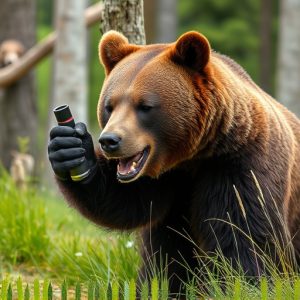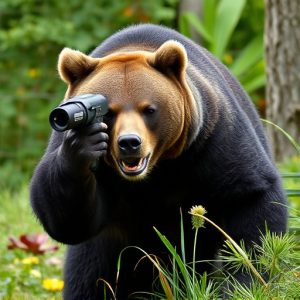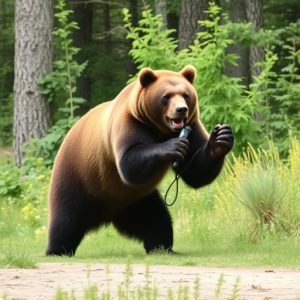Maximizing Protection: Bear Spray Fog Pattern Test & Effective Range Analysis
The Bear Spray Fog Pattern Test is a crucial evaluation determining the effective range (up to 30 fe…….
The Bear Spray Fog Pattern Test is a crucial evaluation determining the effective range (up to 30 feet) and dispersion of bear spray, guiding users on optimal application distance for maximum effectiveness during encounters. Results inform manufacturers and regulators, enabling them to set responsible usage guidelines and provide accurate safety information in bear country. By understanding variables like wind speed, humidity, and terrain, users can optimize the use of bear spray, which is effective against both black and grizzly bears, deterring them without causing harm. Proper application techniques and practice with fog pattern tests are key to its success in backcountry hiking, camping, and reducing human-bear conflict.
Bear spray is a popular self-defense tool in bear country, but its effectiveness depends on understanding its fog pattern. The average bear spray has a range of up to 30 feet, creating a protective barrier of irritants. This article delves into the science behind the Bear Spray Fog Pattern Test, exploring factors influencing its range and providing insights into optimal use cases. We’ll also compare it with other deterrents and offer safety precautions for responsible usage.
- Understanding Bear Spray Fog Pattern Test
- Factors Influencing Bear Spray Range
- Effective Use Cases of Bear Spray
- Comparison with Other Bear Deterrents
- Safety Precautions and Best Practices
Understanding Bear Spray Fog Pattern Test
Understanding Bear Spray Fog Pattern Test
The Bear Spray Fog Pattern Test is a crucial assessment that determines the effective range and dispersion of bear spray. This test simulates real-world scenarios where individuals may need to use bear spray as a defense mechanism. By analyzing the fog pattern, experts can gauge how far the spray reaches and how it disperses in different environmental conditions. This knowledge helps users understand the optimal distance for application and ensures maximum effectiveness during potential encounters with bears.
This test provides valuable insights into the product’s performance, highlighting its reach and coverage area. The results help manufacturers and regulators set guidelines for responsible usage, ensuring that individuals have accurate information about their defense options in bear country. Understanding the Bear Spray Fog Pattern Test is thus essential for anyone looking to make informed decisions regarding personal safety in bear-inhabited areas.
Factors Influencing Bear Spray Range
The effective range of bear spray is often touted as thirty feet, but several factors can influence this distance. One key aspect is the spray pattern created by the canister—a uniform fog or a concentrated stream can affect how far the spray reaches. The Bear Spray Fog Pattern Test is a method used to measure and understand these variations. By analyzing the distribution of spray particles, researchers and manufacturers can optimize the design for maximum effectiveness.
Additionally, environmental conditions play a significant role. Wind speed and direction, humidity, temperature, and terrain all contribute to how far bear spray can travel. For instance, in windy conditions, the spray might dissipate more quickly and cover a shorter distance, while in still air or with a favorable wind, it could reach further. Understanding these variables is crucial for users to ensure the safety and success of using bear spray in various settings.
Effective Use Cases of Bear Spray
Bear spray, with its effective range of thirty feet, is a powerful tool for deterring bears in various outdoor scenarios. One of its key use cases lies in backcountry hiking and camping where encounters with black or grizzly bears are possible. The Bear Spray Fog Pattern Test has shown that when used correctly, bear spray can create a protective barrier, causing bears to retreat without causing harm. This makes it an essential addition to any outdoor enthusiast’s safety kit.
Additionally, bear spray is invaluable for wildlife management and conservation efforts. It aids in reducing conflict between humans and bears, particularly in areas where bears have become accustomed to human food sources. By spraying bears at the first sign of aggression or when they approach too closely, individuals can disrupt their feeding patterns and encourage them to return to natural habitats, thus minimizing potential damage to both the environment and human safety.
Comparison with Other Bear Deterrents
When compared to other bear deterrents, bear spray stands out for its effective range of thirty feet. This is significantly farther than options like noise makers or bells, which typically have a range of just a few yards. Moreover, unlike physical barriers or traps, bear spray doesn’t restrict movement or cause harm to the animal.
The fog pattern test reveals that bear spray creates a dense cloud of irritants that can be detected by bears up to 30 feet away. This unique delivery system ensures that the spray reaches the bear’s eyes, nose, and mouth, making it an effective deterrent in various environments. In contrast, other methods often rely on chance encounters or proximity to work, leaving them less reliable in situations where bears are startled or aggressive.
Safety Precautions and Best Practices
When using bear spray, it’s crucial to understand its effective range and the optimal application technique for maximum safety. The spray creates a fog pattern that can reach up to thirty feet, allowing users to defend themselves from bears at a distance. However, this range is not a guarantee of protection if not used properly.
Best practices include ensuring good visibility and targeting the bear’s face and eyes. During a confrontation, aim for the closest approaching bear, as the spray dissipates with distance. It’s recommended to practice with fog pattern tests to understand the spray’s behavior and timing. Always keep your bear spray readily accessible and ensure it is in good working condition before venturing into potential bear country.


